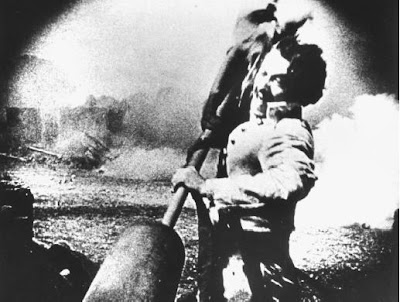The Birth of a Nation (D.W. Griffith, 1915): USA
Reviewed by Byron Potau. Viewed on DVD.

D.W. Griffith’s great epic, The Birth of a Nation, has been the subject of much controversy. While it has been praised for its many innovations it has been equally lambasted for its championing of the Ku Klux Klan, and for its obvious racism and historical inaccuracies. However, the film’s importance seems to be too great to ignore.
Focusing on two families, the northern Stonemans, whose father Austin (Ralph Lewis) is an abolitionist Congressman, and the southern Camerons, the film tells the story of the Civil War and the reconstruction of the south after the war. Two of the Stoneman brothers, Phil (Elmer Clifton) and Tod (Robert Harron), visit the home and family of their friend Ben Cameron (Henry B. Walthall). Phil and Ben’s sister Margaret (Miriam Cooper) immediately fall for each other as Ben falls for Phil’s sister Elsie (Lillian Gish) through her photograph which Phil gives to Ben. They learn of tensions between north and south brought about by the election and the Stonemans return home. The war breaks out and the Stoneman and Cameron sons are on opposite sides of the war. When the war ends both sides have incurred casualties with only Ben and Phil the only sons from their families to survive the war.
The second half of the film deals with the reconstruction of the south. President Lincoln is assassinated and Congressman Austin Stoneman is able to carry out his plans of empowering the southern blacks while suppressing the southern whites. Whites are prevented from voting while blacks stuff the ballot boxes electing Congressman Stoneman’s protégé the mulatto Silas Lynch (George Siegmann). The blacks are allowed to oppress the whites until Ben is inspired to create the Ku Klux Klan which will eventually be the savior of the south.
Probably the film’s greatest point of contention is its obvious racism. While Griffith attempted to accurately portray the Civil War, his portrayal of the reconstruction afterward has been hotly disputed, though there is still not a full agreement as to how inaccurate it is. In order to really enjoy the film and appreciate its greatness it is best to think of it as a rewriting, or some might say disregard, of history, kind of like Inglourious Basterds. This is something of a fantasy based on a larger real event. If you can get past that point then you can see the film for its great storytelling and easily shirk off its blatant racism as mere fiction.
One difficult thing to consider when watching a silent film this old is how much can you forgive. Certainly, some allowances have to be made due to a film’s age, but there is also the danger of letting a film off the hook too easily. The Birth of a Nation is dated in some areas, but does not ask us to forgive much, still holding up very well today due to the clarity of its storytelling. Even its obvious racism seems to be a byproduct of its time given how popular the film was.
One ridiculous scene that you cannot blame on the film’s age is when, while Col. Ben Cameron is in the hospital with his mother visiting and Elsie nursing him, he receives the news that he is to be hanged as a war guerrilla. Elsie grabs Ben’s mother and they get an immediate audience with none other than President Lincoln who hears thirty seconds of the mother’s plea and signs a pardon for Ben. The scene amounts to little more than a joke with the danger introduced and resolved within five minutes. It could have, and should have, easily ended up on the cutting room floor. Instead we are forced to roll our eyes at such drivel in what is easily the worst scene in the film. Fortunately, this scene is the exception in this film.
Griffith was also very adept at directing actors and here he gets two fine performances from Henry B. Walthall and Lillian Gish. Both actors are able to reveal much in subtle gestures and facial expressions captured by Griffith and cinematographer G.W. Bitzer. Yet while we get these great performances we have to endure several negative portrayals of blacks by white actors in blackface. Though you wouldn’t see that today it was not uncommon then and is one of the allowances the audience is forced to make.
In addition to his work with the actors Griffith manages some rousing action and rescue scenes, upping the suspense despite the involvement of the Ku Klux Klan. These scenes have great energy and Griffith is very good at handling scenes with large crowds. He is also able to allow the audience to follow multiple lines of action, successfully crosscutting between scenes with exceptional clarity to a dramatic climax.
Often mistaken as the first feature film, there were, in fact, feature length films dating back to the mid 1900’s, but after the success of The Birth of a Nation features became the norm. It was also on a scale like no other film before it, clocking in at three and a half hours, essentially becoming the first epic film. Many innovations of filmmaking began here and the film is rightly celebrated for them, its greatest in my opinion being its ability to convey the action on the screen through the cinematic language Griffith developed. It is a great film, but for many reasons is not an easy one to watch but one you should make time for. Yet, you might just want to schedule an intermission.
About this entry
You’re currently reading “The Birth of a Nation (D.W. Griffith, 1915): USA,” an entry on Student Film Reviews
- Published:
- 03.12.10 / 2am
- Category:
- DVD, Films, Silent films
15 Comments
Jump to comment form | comments rss [?] | trackback uri [?]